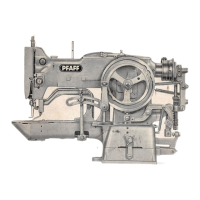21.
Timing
the
Knife
Cam
Shortly before the machine stops, the knife cam
causes
the knives to be moved from
the Inoperative to the operative position, and after the
machine
has stopped, operates
tripping
lever t
(Fig.
19)
and
knife
bar
M.
Knife
cam u is screwed to hub cover f
which,
in
turn,
is
pinned
to
the
transverse
shaft.
The four screwholes in hub cover f are elongated so that the position of the knife cam
on the shaft can be adjusted after loosening the four screws q.
Set the
knife
cam so that
knife
motion
begins
when
the needle has passed the
highest
point of its stroke and begins to descend for the last stitch. Since gear ratios
vary
with
each
subclass
machine, no hard and fast rule can be given for the elimination of minor
deviations. If additional adjustment is required, reset the knife
bar
as instructed in the
following
chapter..Note as a general rule that the needle should pass between the knife
tips when It
descends
for the last stitch of
one
seam
and the first four stitches of the
next
seam.
msmmm
22.
Adjusting
the
Knife
Bar
The
throw initiated by knife
cam
u (Fig. 19) Is
transmitted
to
the
knives
below
the
needle
plate
by
means
of
tripping
lever
X
and
knife
bar
l\A.
The knife bar carries a rack at its front end which meshes with the knife carrier pinion.
Its
rear
end
is
connected
to tripping lever t by
means
of an adjustable fork.
Loosen
screws
r
and
s (Fig. 19)
and
set
knife
bar
M
so
that
there
is a
clearance
of
about
Vaj"—Vii"
(7—8
millimeters) between tip of bobbin
thread
knife U and the
needle
hole
when
the
knife is
Inoperative
(Fig. 20).
No
gauge
Is required for this setting. Simply adjust the knife bar until the tip of the
bobbin
thread
knife is in line with
the
top
left
edge
of
the
shuttle
race.
Note
also
the
Instructions
given
in
the
preceding
chapter.
^-•Greiferbahn-kanle
i *

